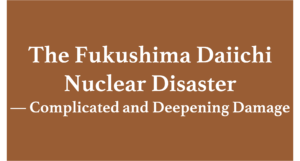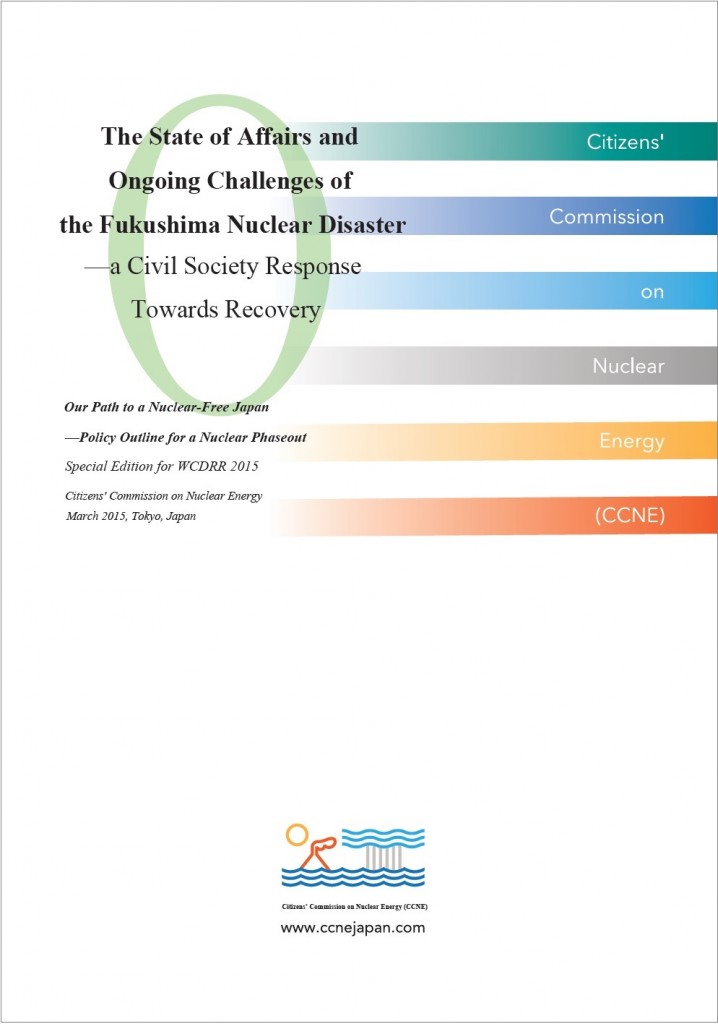1. Current Situation at the Fukushima Daiichi Nuclear Power Plant
The government and TEPCO have presented a “Mid-and-Long-Term Roadmap towards the Decommissioning of TEPCO’s Fukushima Daiichi (No.1) Nuclear Power Station Units 1-4” and are aiming to complete the decommissioning of the Fukushima Daiichi NPS within 30 to 40 years. However, the path ahead is not at all clear.
The specific tasks to be tackled are the countermeasures against contaminated water, the removal of spent nuclear fuel from the spent fuel pools of Units 1, 2 and 3, the removal of (molten) fuel debris, and the countermeasures against radioactive waste.
(These are the issues presented in the “Mid-and-Long-Term Roadmap“. The Citizens’ Commission on Nuclear Energy (CCNE) has proposed that the removal of fuel debris should not be pushed forward unduly rapidly, and that the Fukushima Daiichi NPS buildings should be covered by shielding, etc. and kept isolated for more than 100 years.)
![]() Removal of spent nuclear fuel
Removal of spent nuclear fuel
- Removal of fuel from the Unit 4 spent fuel pool was completed in December 2014.
- Removal of fuel from the Unit 3 spent fuel pool was scheduled to begin in “mid” fiscal year 2018 (April 2018 to March 2019), but continuing problems caused the work to be postponed until April 2019.
- TEPCO has yet to begin fuel removal from the Units 1 and 2 spent fuel pools.
![]() Removal of fuel debris
Removal of fuel debris
In February 2019, it was reported that remote control contact had been achieved with debris in Unit 2, and this was emphasized as a major step toward debris removal.
However, little progress has been made on the consideration of technical issues such as how to remove and transport the extremely radioactive debris, or on social issues such as where it might be stored. The situation in which attention was given only to the fact that the debris was seen and touched suggests, conversely, that the difficulties faced in decommissioning the reactors are not properly understood.
![]() Measures against contaminated water
Measures against contaminated water
Cooling water is still being circulated and injected to cool the fuel debris of the molten down reactors of Units 1-3, and 150 tons of contaminated water is being generated each day. In order to reduce the amount of groundwater flowing into the basements of the buildings, the installation of groundwater bypasses and a frozen soil barrier, and the pumping of groundwater from sub-drains (multiple wells around the buildings) have been implemented, but the effects have not been clear. In fact, the total amount of contaminated water stored in the basements of Units 1-3 and in onsite tanks has continued to increase, exceeding 1.17 million cubic meters as of the end of October 2019.
In 2018, there was a strong movement to release into the ocean the contaminated water (ALPS treated water – water that has been treated by the “ALPS” multi-nuclide removal equipment) stored in the onsite tanks. The reason was that the increase in the number of contaminated water tanks had resulted in a shortage of available land within the premises of the Fukushima Daiichi NPS, which would hinder future work such as removing debris. However, media reports in August 2018 revealed that radioactive nuclides such as iodine 129, strontium 90 and ruthenium 106 exceeding regulatory standards remained in the ALPS-treated water, from which radioactive materials other than tritium should have been removed. At “public hearings” held by the Ministry of Economy, Trade and Industry (METI), fishermen and residents of Fukushima Prefecture voiced strong opposition to the plan. As of December 2019, the ALPS-treated water was still under discussion in a METI subcommittee, while the government and TEPCO are still attempting to release the water into the ocean, resulting in an unpredictable situation.


